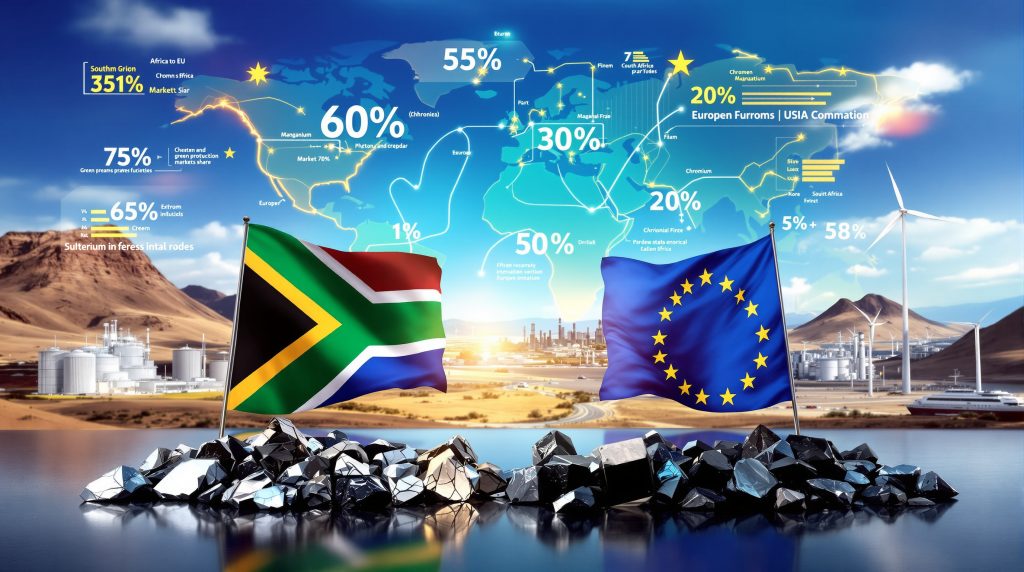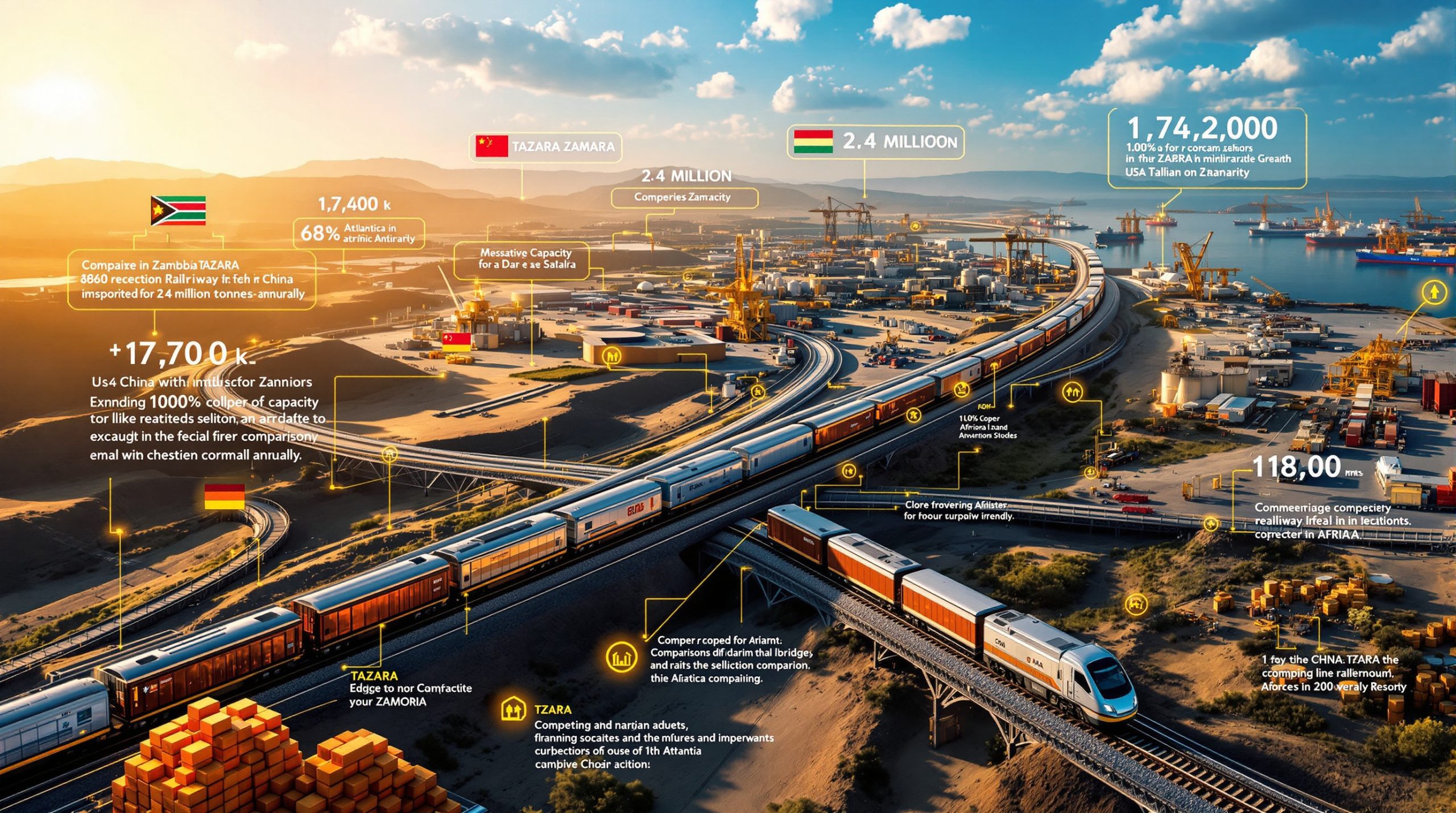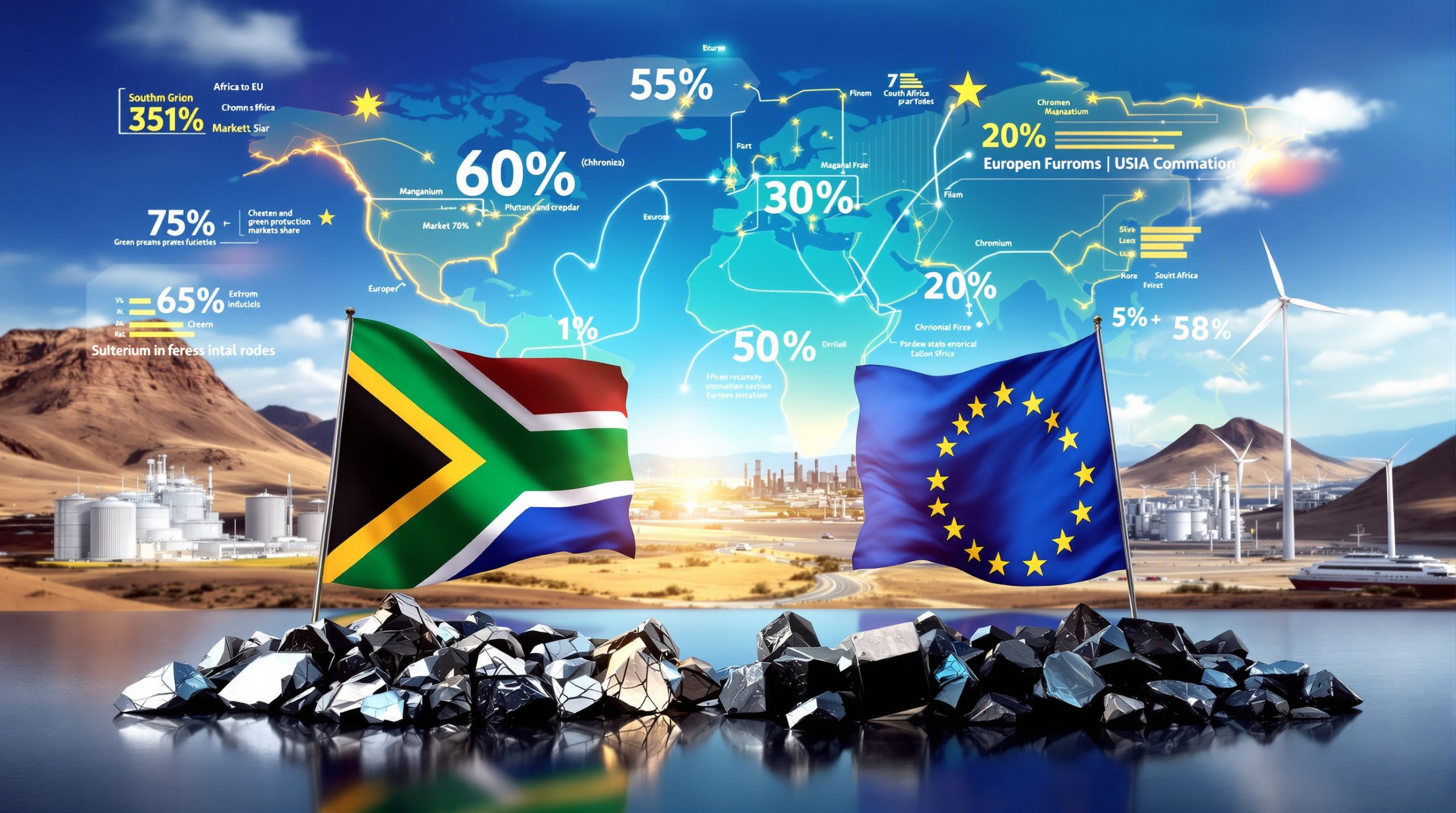South Africa and EU critical minerals partnership negotiations represent a pivotal moment in global resource strategy, as nations recognise the urgent need to secure reliable access to materials essential for technological advancement and energy transition. This shift fundamentally alters traditional commodity relationships, with resource-rich countries and developed economies creating sophisticated alliances that prioritise value-added processing over simple extraction models.
The mining sector increasingly acknowledges that future competitiveness depends not merely on extraction capabilities, but on integrated value chain development through critical minerals energy transition approaches. This evolution creates complex interdependencies between resource endowments, processing infrastructure, and end-market demand patterns across multiple industrial sectors.
Strategic Framework Architecture of Resource Security
The November 2025 diplomatic breakthrough between South Africa and the European Union establishes comprehensive cooperation mechanisms spanning economic, technological, and political dimensions. President Cyril Ramaphosa emphasised the partnership's transformative potential, stating that South Africa would no longer rely solely on mineral extraction but would process materials at extraction points.
This bilateral arrangement creates structured pathways for local beneficiation in South Africa through targeted investment flows and technology transfer commitments. The framework prioritises proximity-based value addition, transforming raw material extraction sites into integrated industrial ecosystems that generate higher-value employment opportunities and economic multiplier effects.
The partnership encompasses dual agreements designed for operational flexibility: streamlined mechanisms that enable rapid responses to market disruptions or technological changes without comprehensive renegotiation requirements. This adaptive approach addresses the dynamic nature of critical minerals markets where supply-demand imbalances can emerge rapidly due to technological breakthroughs or geopolitical developments.
European Commission President Ursula von der Leyen highlighted supply security imperatives, noting that Europe requires reliable critical mineral inputs to power clean energy transitions both domestically and internationally. The continent's economic future depends fundamentally on fair and reliable supply chain structures established through the Clean Trade and Investment Partnership.
Critical Minerals Market Vulnerability Assessment
European industrial strategy confronts acute concentration risks across multiple critical mineral categories, particularly regarding rare earth elements where single-source dependencies threaten manufacturing continuity in automotive, renewable energy, and defense applications. Russia's conflict in Ukraine demonstrated how supply disruptions can cascade through interconnected industrial systems.
The partnership addresses these vulnerabilities through geographic diversification strategies and strategic stockpiling mechanisms. Furthermore, the EU's comprehensive approach includes establishing a joint purchasing mechanism valued at €9 million, designed to secure critical material supplies before competing nations implement similar strategies.
South Africa's mineral endowments position the country as a strategic alternative supplier for multiple critical materials. The nation holds substantial reserves across platinum group metals, manganese, and chromium sectors, though specific reserve percentages require verification through official geological survey data.
EU leaders recognise the urgency of diversifying supply sources as they scramble to secure dozens of metals vital for renewable energy transitions, computing revolution requirements, and defense applications. This scramble occurs against the backdrop of potentially damaging supply restrictions from China, currently the world's dominant rare earth element supplier.
The strategic timing of this partnership coincides with South Africa hosting the G20 summit, providing additional diplomatic momentum for bilateral cooperation initiatives. This geopolitical context creates opportunities for expanded trade relationships while major powers navigate complex multilateral dynamics.
Infrastructure Transformation Through Processing Development
The partnership mandates comprehensive local processing capability development, fundamentally shifting from traditional raw material export models toward integrated value chains. This transformation involves establishing smelting, refining, and component manufacturing facilities within designated South African industrial zones through mining industry innovation approaches.
Investment commitments support this infrastructure transition through blended finance mechanisms targeting multiple sectors:
• Green hydrogen production facilities leveraging South Africa's renewable energy potential
• Battery manufacturing operations capturing lithium-ion and advanced battery technology markets
• Transport infrastructure decarbonisation projects reducing logistics emissions
• Advanced materials processing plants for aerospace and defence applications
These investments create significant economic multiplier effects across related industries while establishing long-term supply security arrangements for European manufacturers. In addition, the integrated approach maximises resource utilisation efficiency while minimising environmental impact through consolidated processing operations.
Technology transfer mechanisms enable European advanced processing expertise to establish operations within South African facilities, creating regional centres of excellence that can serve broader African markets. This knowledge transfer approach builds lasting technological capabilities rather than temporary operational arrangements.
The infrastructure development prioritises sustainability standards alignment between European and South African regulatory frameworks, facilitating seamless trade flows while maintaining environmental performance benchmarks throughout supply chains.
Geopolitical Scenario Modelling and Strategic Implications
Several strategic scenarios emerge from this alliance, each carrying distinct implications for global mineral markets and international cooperation frameworks through comprehensive critical minerals strategy implementation.
Multilateral Expansion Pathway
The partnership potentially becomes a template for similar agreements between the EU and other resource-rich African nations. This scenario creates comprehensive alternative supply networks that reduce Chinese market dominance while strengthening multilateral cooperation frameworks and enhancing global supply chain resilience through geographic diversification.
Competitive Response Intensification
China may respond with increased investment in African mining operations and processing facilities, potentially creating competing influence spheres across the continent. This scenario could accelerate infrastructure development but might also increase geopolitical tensions over resource access and economic influence.
Technology Transfer Acceleration
European advanced processing technologies establishing operations in South African facilities creates regional expertise centres serving continental markets. This positions South Africa as a hub for critical minerals processing and component manufacturing across sub-Saharan Africa.
The partnership announcement occurs amid South Africa's G20 hosting responsibilities, with President Ramaphosa noting that the United States is considering some form of participation despite earlier boycott indications. Consequently, this diplomatic context influences the alliance's broader geopolitical significance beyond bilateral trade arrangements.
Analysts view potential U.S. absence from G20 proceedings as an opportunity for South Africa to strengthen relationships with the EU and China, its two largest trading partners. This dynamic creates additional strategic value for the South Africa and EU critical minerals partnership within broader international relations frameworks.
Energy Transition Integration with Minerals Policy
The partnership aligns critical minerals extraction with renewable energy manufacturing requirements, creating integrated supply chains for solar panels, wind turbines, and battery systems. This integration reduces transportation costs and carbon footprints while building regional manufacturing capabilities that capture value-added economic benefits.
Green hydrogen initiatives leverage South Africa's substantial renewable energy potential alongside its mineral resource endowments, creating dual export opportunities for processed minerals and clean energy carriers. This approach maximises economic returns from natural resource advantages while supporting global decarbonisation objectives.
Von der Leyen emphasised that Russia's conflict in Ukraine awakened Europe to the necessity of diversified energy supply sources, extending this lesson to critical minerals required for clean energy infrastructure. The South Africa and EU critical minerals partnership addresses both energy security and materials security through coordinated strategic planning according to EU officials.
Manufacturing synergies emerge where critical minerals processing facilities co-locate with renewable energy generation assets, creating industrial clusters that optimise resource utilisation and minimise environmental impact. These clusters can serve as models for sustainable industrial development across Africa.
The energy-minerals integration approach supports circular economy principles through recycling, reuse, and waste minimisation throughout value chains, creating closed-loop systems that maximise resource efficiency while reducing environmental degradation.
Investment Opportunity Landscape
Infrastructure development requirements create substantial investment opportunities across multiple sectors. Transportation networks, port facilities, and processing plants require significant capital investment to support increased mineral processing volumes and component manufacturing operations through advanced mine planning methodologies.
Key investment categories include:
• Engineering and construction firms specialising in mining infrastructure development
• Equipment suppliers for advanced processing technology and automation systems
• Logistics companies managing complex supply chain coordination requirements
• Technology companies developing sustainable extraction methods and environmental monitoring systems
Joint research and development initiatives focus on sustainable extraction methods, advanced processing technologies, and circular economy applications. These programmes create opportunities for specialised technology companies working in mining automation, environmental monitoring, and waste reduction systems.
The blended finance approach combines public and private sector resources to reduce investment risks while maintaining commercial viability for private sector participants. This structure enables larger-scale infrastructure development than traditional financing mechanisms alone could support.
Financial institutions benefit from structured financing opportunities that support both economic development objectives and commercial returns through diversified industrial development projects with long-term revenue streams.
Industrial Sector Impact Analysis
Automotive Manufacturing Transformation
European automotive manufacturers gain improved access to platinum group metals essential for fuel cell technology development and catalytic converter production. Battery material supply chains become more resilient through diversified sourcing arrangements that reduce dependence on single suppliers.
Renewable Energy Manufacturing
Solar panel and wind turbine manufacturers benefit from stable supplies of critical materials including rare earth elements and specialty metals required for high-efficiency energy conversion systems. This supply security enables long-term production planning and technology advancement initiatives.
Defence and Aerospace Applications
Advanced materials requirements for defence systems and aerospace components gain additional supply source options, reducing strategic vulnerability while maintaining technology performance standards.
The partnership creates competitive advantages for European manufacturers through preferential access to critical materials combined with processing quality controls that meet advanced manufacturing specifications.
Global Trade Pattern Transformation
Traditional North-South commodity flows transform into complex value-added trade relationships where processed materials and components replace bulk raw material exports. This shift creates higher-value employment opportunities and increased economic integration between regions.
The partnership potentially reduces European dependence on Asian supply chains while creating new competitive dynamics in global critical minerals markets. However, this restructuring influences pricing mechanisms and long-term supply contract structures across multiple industrial sectors.
Regional value chain development changes trade flows by establishing processing capabilities closer to extraction sites, reducing transportation costs and carbon emissions. Furthermore, it creates economic benefits for source regions rather than solely benefiting end-market locations.
The competitive positioning changes may influence other major economies to develop similar strategic partnerships with resource-rich nations, potentially leading to a restructuring of global trade relationships around critical materials supply security.
Regulatory Framework Innovation
The South Africa and EU critical minerals partnership introduces flexible regulatory cooperation mechanisms that adapt to evolving market conditions without requiring comprehensive renegotiation processes. This approach enables rapid responses to supply chain disruptions or technological changes that affect critical minerals markets.
Standards harmonisation processes between European and South African regulatory frameworks facilitate seamless trade flows while maintaining high sustainability benchmarks throughout supply chains. This regulatory alignment reduces compliance costs and administrative barriers for companies operating across both regions.
Environmental, safety, and quality standards coordination ensures that local processing operations meet European market requirements while supporting South African industrial development objectives.
The regulatory innovation approach may serve as a model for other international cooperation agreements, demonstrating how flexible frameworks can balance economic development with environmental protection and social responsibility requirements.
Climate Change Mitigation Integration
Local processing reduces transportation-related emissions by minimising the distance between extraction and initial processing operations. European technology transfer improves extraction efficiency and environmental performance, contributing to overall supply chain decarbonisation objectives.
The partnership emphasises circular economy integration throughout critical minerals value chains, creating closed-loop systems that maximise resource utilisation. In addition, it minimises environmental impact through recycling, reuse, and waste reduction initiatives.
Carbon footprint reduction strategies align with both European climate objectives and South African sustainable development goals, creating mutual benefits that strengthen long-term cooperation incentives.
The climate integration approach demonstrates how resource extraction and processing can support rather than conflict with environmental protection objectives through advanced technology application and sustainable practices implementation.
Long-Term Strategic Success Metrics
Economic diversification outcomes for South Africa include increased value-added manufacturing capabilities that reduce dependence on raw commodity exports. These capabilities create more stable revenue streams and higher-skilled employment opportunities across multiple industrial sectors.
The partnership positions South Africa as a potential continental leader in sustainable mining practices and critical minerals processing, attracting additional investment and technology transfer opportunities from other developed economies seeking supply chain diversification.
Regional leadership development creates spillover benefits across sub-Saharan Africa as South African expertise and infrastructure serve broader continental markets, supporting regional economic integration and development objectives.
Success metrics include measurable improvements in local value addition, employment quality, environmental performance, and supply chain resilience that benefit both partnership participants and broader regional development goals.
The South Africa and EU critical minerals partnership represents a fundamental shift toward strategic resource cooperation that balances economic development with environmental sustainability objectives. Implementation success depends on effective development of processing infrastructure, technology transfer mechanisms, and regulatory harmonisation processes that create mutual benefits while strengthening global supply chain resilience.
This alliance demonstrates how bilateral cooperation can address complex challenges including supply security, economic development, and climate objectives through integrated approaches that transcend traditional commodity trading relationships. The partnership's broader significance lies in its potential to serve as a model for strategic resource cooperation between developed and developing economies.
Disclaimer: This analysis contains forward-looking statements and projections based on currently available information. Critical minerals markets are subject to significant volatility due to geopolitical developments, technological changes, and supply-demand dynamics. Investment decisions should consider comprehensive risk assessments and professional financial advice.
Are You Positioning for the Next Critical Minerals Breakthrough?
Discovery Alert's proprietary Discovery IQ model delivers real-time alerts on significant ASX mineral discoveries across critical minerals sectors, empowering subscribers to identify actionable opportunities ahead of broader market recognition. With partnerships like South Africa's EU alliance reshaping global supply chains, explore historic examples of exceptional discovery returns and begin your 30-day free trial to secure your market-leading advantage in this rapidly evolving sector.




